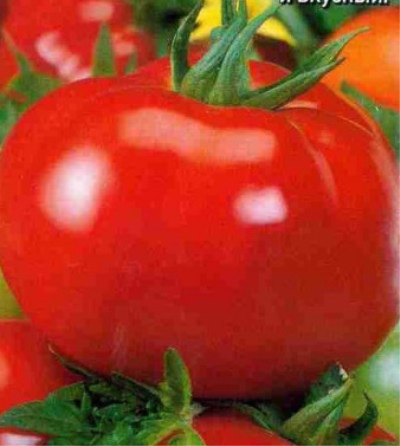
- Authors: Nastenko N.V., Kachainik V.G., Kandoba A.V. (Agrofirma Aelita LLC)
- Year of approval: 2008
- Category: hybrid
- Growth type: determinant
- Appointment: fresh consumption
- Ripening period: early
- Ripening time, days: 85-90
- Growing conditions: for open ground, for film greenhouses
- Marketability: high
- Transportability: high
The tomato in question is perfect for gardeners who grow vegetables for sale. Beautiful early-ripening tomatoes will take their rightful place on the shelves. Hybrid Pyshka is unpretentious to care, resistant to a number of dangerous tomato diseases.
Breeding history
Tomato Pyshka is a hybrid of the first generation, bred by domestic breeders. Authors - N.V. Nastenko, candidate of agricultural sciences, V.G. Kachainik, candidate of agricultural sciences, A.V. Kandoba. Originator - Agrofirma Aelita LLC. The hybrid was entered into the State Register in 2008.
Description of the variety
Tomato Pyshka is recommended to grow in open ground, as well as in film greenhouses. Determinant type of growth. The plant is undersized - the bushes are only about 60 cm in height. Leafiness is medium. The leaves are large, dark green, slightly pubescent. The peduncle is articulated. Inflorescences are single-branched (intermediate type). The purpose of tomatoes is salad. But they are also suitable for making ketchups and sauces, juice. You can also preserve. Tomatoes do not burst in jars. You can store Pyshka, but it will not be suitable for long-term storage. Transportation is possible.
The main qualities of the fruit
The fruits have an excellent presentation. The shape is rounded. They are aligned in weight and size. The average weight of tomatoes is about 150-200 g. The surface of the fruits is smooth, glossy, medium soft. The color is pure red. Fruits are evenly colored, there are no yellow-orange spots near the stalk. The pulp is fleshy, the seed chambers are 4-5 pieces. The seeds are small, almost not felt during the meal.
The fruits of the Pyshka hybrid are not prone to cracking.
Taste characteristics
Tomatoes are fleshy, tasty, sweet and sour. The skin is not thick.
Ripening and fruiting
Ripening - early ripe tomato. After 3 months from the date of emergence, the first harvest begins. The fruits turn red together.
Yield
The harvest is high. About 1 kg of the crop is harvested from each bush of Pyshki. When growing tomatoes in a greenhouse, under film shelters, from 1 sq. m you can get 9-10 kg of delicious tomatoes.
The timing of planting seedlings and planting in the ground
Sowing is carried out in February. Seedlings appear in 3-5 days. Seed germination - more than 92%. A pick is carried out when 1-2 true leaves appear. On day 55-60, they are planted in a greenhouse. Usually at this time the first brushes with flowers already appear.
Landing in open ground is carried out after the threat of morning frost has passed. Therefore, for each region, you can calculate the planting time independently based on local climatic conditions.

Growing tomato seedlings is an extremely important process, because it largely depends on whether the gardener will be able to harvest at all. All aspects must be taken into account, from seedbed preparation to planting in the ground.
Landing scheme
The bushes are planted in a checkerboard pattern. The distance between the rows is about 0.5 m, and in the rows - 0.3 m. This is the most suitable way of placement. With this scheme, 1 sq. m place 10 tomato bushes.

Growing and care
A garter to the support is required. Formation of bushes - 2-3 stems. To obtain a high yield, plants need to be weeded, loosened and fertilized regularly. Watering is carried out with warm, settled water, in the evening or morning hours. Under each bush - 4 liters of water with a temperature of 23-24 degrees. The crumpet is undemanding to water, 1 watering per week is enough. Plants are fed 4 times per season.
The stepsons are removed - once a week. The lower leaves are removed as needed.




A plant needs different micronutrients at each stage of growth. All fertilizers can be divided into two groups: mineral and organic. Folk remedies are often used: iodine, yeast, bird droppings, eggshells.
It is important to observe the rate and period of feeding. This also applies to folk remedies and organic fertilizers.
Disease and pest resistance
The hybrid is resistant to fungal disease - fusarium wilt and viral - tobacco mosaic.
Late blight is dangerous for this hybrid. To avoid it, they carry out preventive measures to prevent the disease. For this, both chemicals and folk remedies are used.


Resistant to adverse weather conditions
The Pyshka hybrid is resistant to sudden changes in weather conditions. It tolerates temperature extremes, fluctuations in humidity levels. In conditions of lack of water and minerals, it bears fruit well. But in order to obtain the maximum possible yield, it is necessary to observe the irrigation regime, apply fertilizers in a timely manner, and fight weeds, diseases and pests.
Growing regions
Pyshka tomatoes are grown practically throughout Russia.
Review overview
There are many reviews on the Internet about this tomato. Basically, it is characterized as an unpretentious undersized variety that has rather large fruits. This feature is not often found among undersized varieties.
The vitality of Pyshka tomatoes is noted, its ability to endure hot, dry weather.
Positive feedback can be heard from those summer residents who cannot often come to their plots. Since Pyshka is resistant to short-term droughts. Rare watering is not terrible for the harvest.
Among the diseases to which the Pyshka hybrid is susceptible, late blight and cladosporiosis are noted.

























































































